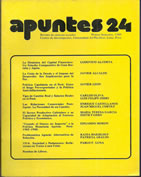Apuntes 24

The articles in this issue: Compare the dynamics of the links between banking and industry in the United Kingdom and Japan; Argue that the conventional development model, based on intensive investment and industrialization, has brought the extraordinary era of world economic growth to a halt; Account for how two types of exchange policy (crawling peg with a parity criterion and a long period-fixed exchange rate) have influenced the evolution of an effective real exchange rate over the last four years; Attempt to define and quantify the relationship between exchange and labor markets, based on the real exchange rate and real wages, in the case of the Peruvian economy over the period 1971-1987; Provide a historical and analytical review of Peruvian-Japanese trade relations and the need for change to maximize Peru's export potential; Focus on the crisis facing Peruvian coffee production, and the industry’s need for specific policy incentives and a stable economy; Critique the different aspects of monetary policy during the first three years of the APRA government; Analyze the Peruvian agricultural sector and the proposed remedies arising from the 1st Congress of the National Agrarian Organization; Provide a historical account of the Peruvian financial crisis of 1914, and what it reveals about the practices and idiosyncrasies of the Peruvian state at that time.


.jpg)
